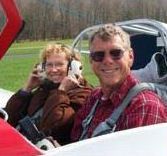
Tom Knauff and Doris Grove
Glider Safety Webinar For Your Club
Doris and I just returned from a very successful Flight Instructor Revalidation Clinic we conducted (with the help of Jack Goritski) in Frederick, Maryland. We will now head south for The Seniors contest before the spring ridge season begins.
We had a large group of CFIs and non-CFIs in attendance, along with a representative of the Washington DC FAA office who expressed his appreciation for the professional presentations and emphasis on flight safety. (Other invited FAA officials chose not to attend.)
Reviewing the accident statistics clearly indicates there is a fundamental lack of knowledge among pilots, especially regarding flight safety. Pilots seem willing to spend a lot of money to try to prevent mid-air collisions, which only account for 4% of fatalities, but will not make any effort to change the way they conduct preflight, pre-takeoff, and takeoff procedures which account for some 40% of fatal accidents, nor are they willing to learn and incorporate landing procedures to have an impact on the 40% this category has on fatal glider accidents. (Some 19,000 FLARM devices are now in use around the world.)
There was a lot of praise for the recent glider safety webinars, and recognition this format can have a major impact on flight safety, but how to get pilots to sit for an hour or so to watch a presentation is an entirely different and frustrating matter.
Safety Seminar For Your Club
We are offering to repeat the safety webinars, and broadcast them live to any glider club meeting. This makes it possible for a club or FBO to schedule the event for a regular club meeting so as many members as possible will be able to participate in the live event. We will announce the upcoming scheduled webinars so any pilot from anywhere will be able to participate in any of the webinars. There is a $20 fee requested for each pilot and groups will collect on the honor system..
Of course, most will simply not make the simple effort to improve safety, and there isn’t much that can be done to help. It is very frustrating.
Those who attended this recent FIRC will implement the information and ideas in their club flight operations, and there is much optimism they will have a major impact on flight safety within their organizations.
Glider Safety Webinar For Your Club
Doris and I just returned from a very successful Flight Instructor Revalidation Clinic we conducted (with the help of Jack Goritski) in Frederick, Maryland. We will now head south for The Seniors contest before the spring ridge season begins.
We had a large group of CFIs and non-CFIs in attendance, along with a representative of the Washington DC FAA office who expressed his appreciation for the professional presentations and emphasis on flight safety. (Other invited FAA officials chose not to attend.)
Reviewing the accident statistics clearly indicates there is a fundamental lack of knowledge among pilots, especially regarding flight safety. Pilots seem willing to spend a lot of money to try to prevent mid-air collisions, which only account for 4% of fatalities, but will not make any effort to change the way they conduct preflight, pre-takeoff, and takeoff procedures which account for some 40% of fatal accidents, nor are they willing to learn and incorporate landing procedures to have an impact on the 40% this category has on fatal glider accidents. (Some 19,000 FLARM devices are now in use around the world.)
There was a lot of praise for the recent glider safety webinars, and recognition this format can have a major impact on flight safety, but how to get pilots to sit for an hour or so to watch a presentation is an entirely different and frustrating matter.
Safety Seminar For Your Club
We are offering to repeat the safety webinars, and broadcast them live to any glider club meeting. This makes it possible for a club or FBO to schedule the event for a regular club meeting so as many members as possible will be able to participate in the live event. We will announce the upcoming scheduled webinars so any pilot from anywhere will be able to participate in any of the webinars. There is a $20 fee requested for each pilot and groups will collect on the honor system.
Of course, most will simply not make the simple effort to improve safety, and there isn’t much that can be done to help. It is very frustrating.
Those who attended this recent FIRC will implement the information and ideas in their club flight operations, and there is much optimism they will have a major impact on flight safety within their organizations.






